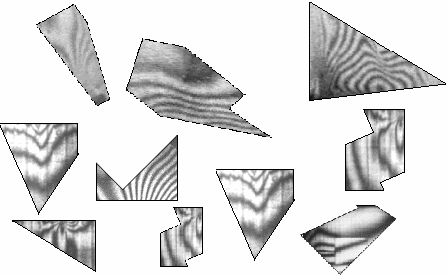1. Basic Terms
1. Basic Terms
Holography is an optic imaging method of obtaining three-dimensional object images based on interference light. The development of holography is connected with the invention of laser. With the aid of the holography we can record solid objects reflecting the light as well as solid transparent objects three-dimensionally in contrast to the photography or cine-camera recording both able to record only 2D pictures of 3D objects.
Hologram is a light wave interferential pattern recorded by utilising coherent laser light on a holographic plate. If the hologram is properly illuminated a three-dimensional image can be obtained.
Rainbow hologram is a hologram created by special technique of optical copying of holograms. Its advantage is the possibility of its reconstruction by white light that splits into the vertical spectrum focused in the plane of the observer′s eyes.
Interferometry is the utilization of the interference of two or more mutually coherent wavelengths and resultant interference fringes for carrying out measurements.
Holographic interferometry mutually compares two information waves that originally did not exist at the same time. Thereby a qualitatively new possibility of considering the influence of another independent dimensional quantity – the time variable – is created.
Laser – a source of light characterised by high intensity, monochromaticity, coherence and small divergence of radiation.
He-Ne laser – a gas laser whose active surroundings are formed by atoms of neon excited in the glowing electric discharge in a mixture of helium and neon.
Interferometers – devices based on the interference of light. They are utilised for measurements of the wavelength of light and refractive indices.
Diffraction – bending of the wave passing round a barrier, otherwise: the wave deviation from the linear direction. The light wave incident on the edge of a non-transparent body diffracts.
Dispersion of light – scattering of light that occurs during its reflection from the rough surface or during its passing through a diffusing medium. Diffusing radiation transmits the energy practically to all directions in the space. In proximity to a diffusive body the lighting by this light does not cast a shadow and is called diffusive (Vrbová, 1994).
Interference of light – composition of waves. On the illuminated surface a characteristic image – interference pattern – is created, for example in the shape of alternating bright and dark fringes. We say that interference of light occurred (Zámečník, Baník, 1988). To obtain the permanent interference, i.e. the phenomenon that can be observed by the naked eye or recorded on a holographic plate, the compound light waves must be coherent.
Coherence is a term characterising regular changes or stability of basic characteristics of the wave (frequency, amplitude, phase, polarisation, vibrations and wave motions) in the space. Wave motions are coherent if their phase difference in time and space are constant. We distinguish the time coherence connected with monochromaticity of the light source and the space coherence connected with dimensions of the light source. Two ideal monochromatic waves of the same frequency are always mutually coherent.
Coherent length is the largest path difference where the interference in the field of two optical beams created by separation of one beam and then travelling on different paths is still observable.



